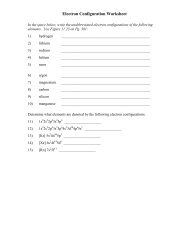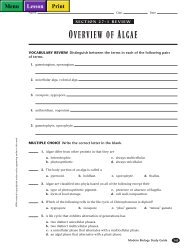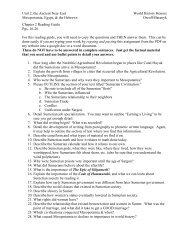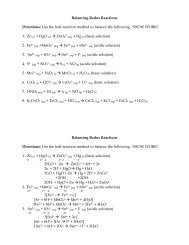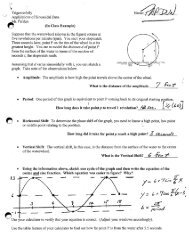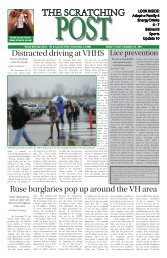The Industrial Revolution (1740-1914)
The Industrial Revolution (1740-1914)
The Industrial Revolution (1740-1914)
Create successful ePaper yourself
Turn your PDF publications into a flip-book with our unique Google optimized e-Paper software.
<strong>The</strong> <strong>Industrial</strong> <strong>Revolution</strong><br />
(<strong>1740</strong>-<strong>1914</strong>)<br />
World History Honors<br />
<strong>The</strong> World before World War I.<br />
Be sure to answer all questions<br />
highlighted in gray!!!!<br />
Orzoff-Baranyk<br />
4/27/2010
Changes caused by the industrial revolution<br />
Location: home & work<br />
- movement to cities & factories (away from country and farming)<br />
- Growth of cities & urban population<br />
Family: small family size, nuclear family only – no extended family, less time spent with them<br />
since work is not done with family.<br />
Education: the opening of public schools.<br />
Wars: deadlier due to new technology<br />
Relationships among nations: competition for markets, materials, power (imperialism)<br />
Ways goods are produced, raw materials procure, and markets are located.<br />
What do you think the relationship between these changes and World War I was?<br />
Reasons the <strong>Industrial</strong> <strong>Revolution</strong> start in Britain in the 18 th century c. <strong>1740</strong><br />
Political<br />
- <strong>The</strong> government supported economic development.<br />
- More intense patterns of global trading for buying raw materials & selling products due to<br />
their global empire.<br />
Economic<br />
- Increasing agricultural productivity due to early technological advances in agriculture. Less<br />
workers needed on the farm.<br />
- Evolution of capitalist philosophy.<br />
- Slave labor in plantation economies enriched the country.<br />
- Discovery of large amounts of gold and silver in New World increased capital<br />
Social<br />
- New merchant class<br />
- Social structure that allowed people of different classes to work together (unlike France’s<br />
Estates)<br />
Intellectual/Technological<br />
- Rise of science & technology focused on finding practical solutions for problems.<br />
- Early factory system established for non-technological jobs led the way for management and<br />
labor to move into large scale factory systems with technology.<br />
Britain’s early industrialization<br />
- Until mid-1700s Britain excelled in wool production.<br />
- India’s cotton textiles gained popularity and began to<br />
replace British wool in the markets.<br />
- Britain banned importation of cotton textiles and<br />
created its own industry.<br />
- <strong>The</strong>y still imported raw cotton from India.<br />
What do you think this meant for India’s economy?<br />
<strong>The</strong> shaded areas are<br />
India’s Cotton growing<br />
regions. Remember – India<br />
was a British colony
New British Inventions<br />
1733 John Kay’s “Flying Shuttle.” A single weaver, instead of the traditional two<br />
weavers, could operate it.<br />
1764 John Hargreaves’ “Spinning Jenny.” It could spin cotton into thread faster – to<br />
keep up with the new demand for it.<br />
Machinery was new but power source was still human labor<br />
Production concentrated in rural homes<br />
New Inventions & New Sources of Power.<br />
1769 Richard Arkwright’s “water frame.” It could spin several strands at the<br />
same time (like the Spinning Jenny), but was powered by running water! This<br />
helped with consistency and soon British cotton textiles were of a better quality<br />
and rivaled India’s.<br />
1712 Thomas Newcomen’s Steam Engine. This used steam to power pumps that<br />
emptied water out of coal mines.<br />
1763 James Watt’s Steam Engine. He created a larger more expensive steam<br />
engine. <strong>The</strong> 1785 firm of Boulton and Watt began to<br />
manufacture and sell steam engines. <strong>The</strong>y replaced<br />
water power. Manufacturing equipment became<br />
more sophisticated and expensive. Steam powered<br />
cotton textile mills that did not have to be near water!
<strong>The</strong> Impact of the Textile Industry on Britain<br />
Much less man power and time needed to produce mass quantities of thread.<br />
Quality of product steadily increased.<br />
Cotton textiles became the most important product of the British economy.<br />
By 1820 it was more than ½ of the exports from Britain!<br />
<strong>The</strong> Impact of the Textile Industry on India & <strong>The</strong> United<br />
States<br />
India became a supplier of raw cotton instead of a<br />
producer of textiles.<br />
Eli Whitney of the USA invented the “cotton gin” that<br />
cleaned seeds from cotton plans quickly.<br />
o USA becomes a supplier of cotton<br />
� 1790: 3000 bales<br />
� 1860: 4,500,000 bales.<br />
o Slavery grows as cotton production grows<br />
Changes to society due to the <strong>Industrial</strong> <strong>Revolution</strong><br />
Before the <strong>Industrial</strong> <strong>Revolution</strong> –<br />
<strong>The</strong> Cottage Industry<br />
People worked at home or close to home. Cotton thread<br />
was made by hand using spinning wheels in someone’s<br />
home. Maybe two to three people would work together in<br />
a single home.<br />
Workers would receive raw materials from a provider, and<br />
return a finished product. <strong>The</strong>y got paid according to how<br />
much of the product they created.<br />
Workers were skilled. All products were made from start to<br />
finish by an individual. His skills would be prized. (ex: only<br />
cobblers made shoes).<br />
Workers tended to work 8-10 hours, ate meals with their<br />
families, or with the boss’s family. More leisure time was<br />
enjoyed. Wages included meals.<br />
By the 1790s – the Cottage Industry was on its way out.<br />
Try to explain the cartoon to the right of a “Typical Factory owner”<br />
During/After the <strong>Industrial</strong> <strong>Revolution</strong> –<br />
<strong>The</strong> Factory System<br />
Work moved into factories. Cotton thread was<br />
made in a huge room by hundreds of people<br />
watching the frames to make sure the thread did<br />
not become tangled.<br />
Workers were paid by the hour. <strong>The</strong>y were<br />
expected to produce a certain amount per day.<br />
Failure to do so could mean loss of a job.<br />
Many hand weavers were driven out of business<br />
because they could not produce quickly enough.<br />
Workers became increasingly less skilled. <strong>The</strong>y<br />
knew how to finish one part of a product, but<br />
would never be able to make the full product on<br />
their own. <strong>The</strong>refore, anyone could learn the jobs<br />
and it was easy to find workers to replace those<br />
who were fired or quit.<br />
Workers worked 12-14 hours. Meals were eaten in<br />
quick breaks between shifts. <strong>The</strong>y usually never<br />
met the person who they worked for. Wages<br />
steadily decreased for a time.
As cities became more crowded the conditions deteriorated<br />
From <strong>The</strong> Condition of the Working Class in England (1845) by Friedrich Engels (son of an English<br />
factory owner)<br />
Heaps of garbage and ashes lie in all directions, and the foul liquids emptied before the doors gather in<br />
stinking pools. Here live the poorest of the poor, the worst paid workers and thieves and the victims of<br />
prostitution indiscriminately huddled together… <strong>The</strong>y who have some kind of shelter are fortunate in<br />
comparison with the utterly homeless. In London fifty thousand human beings get up every morning,<br />
not knowing where they are to lay their heads at night.<br />
From the excerpt above, describe the conditions in which the poor working live, in<br />
your own words:<br />
<strong>The</strong> following parliamentary reports printed in 1842 describe the working conditions for English<br />
women miners:<br />
In England, exclusive of Wales, it is only in some of the colliery districts of Yorkshire and Lancashire that female Children of<br />
tender age and young and adult women are allowed to descend into the coal mines and regularly to perform the kinds of underground<br />
work, and to work for the same number of hours, as boys and men… In many of the collieries in the [Yorkshire] district, as far as<br />
relates to the underground employment, there is no distinction of sex, but the labor is distributed indifferently among both sexes,<br />
except that it is comparatively rare for the women to hew or get the coals, although there are numerous instances in which they<br />
regularly perform even this work. In great numbers of the coal pits in this district the men work in a state of perfect nakedness and<br />
are in this state assisted in the labor by females of all ages, from girls of six years old to women of twenty-one, these females being<br />
themselves quite naked down to the waist.<br />
“Girls” says the Sub-Commissioner, “regularly perform all the various offices of trapping, hurrying, filling, riddling, tipping,<br />
and occasionally getting, just as they are performed by boys. One of the most disgusting sights I have ever seen was that of young<br />
females, dressed like boys in trousers, crawling on all fours, with belts round their waists and chains passing between their legs…<br />
“When I arrived at the board of working on the pit I found at one of the sideboards down a narrow passage a girl of 14 years<br />
of age in boy‟s clothes, picking down the coal with the regular pick used by the men. She was half sitting half lying at her work, and she<br />
said she found it tired her very much, and „of course she didn‟t like it.‟ <strong>The</strong> place where she was at work was not 2 feet high. Further<br />
on were men lying on their sides and getting… In two other pits… I have seen the same sight. In one, the chain passing high up<br />
between the legs of two of these girls, had worn large holes in their trousers; and any sight more disgustingly indecent or revolting<br />
can scarcely be imagined than these girls at work – no brothel can beat it.<br />
“On descending Messrs Hopwood‟s pit at Barnsley, I found assembled round a fire a group of men, boys, and girls some of<br />
whom were of the age of puberty; the girls as well as the boys stark naked down to the waist, their hair bound up with a tight cap, and
trousers supported by their hips. <strong>The</strong>ir sex was recognizable only by their breasts, and some little difficulty occasionally arose in<br />
pointing out to me which were girls and which were boys, and which caused a good deal of laughing and joking.<br />
“When it is remembered that these girls hurry chiefly for men who are not their parents; that they go from 15 to 20 times a<br />
day into a dark chamber, which is often 50 yards apart from any one, to a man working naked, or next to naked, it is not to be<br />
supposed but that where opportunity thus prevails sexual vices are of common occurrence. Add to this the free discussion, and<br />
consider the language to which the young ear is habituated, the absence of religious instruction, and the early age at which<br />
contamination begins, and you will have before you, in the coal-pits where females are employed, the picture of a nursery for juvenile<br />
vice which you will go far and wide above ground to equal.”<br />
Two Women Miners:<br />
Betty Harris, age 37: I was married at 23, and went into a colliery when I was married. I used to weave when about 12 years old; can<br />
neither read nor write. I work for Andrew Knowles, of Little Bolton, and make sometimes 7 shillings a week, sometimes not so much. I<br />
am a drawer, and work from 6 in the morning to 6 at night. Stop about an hour at noon to eat my dinner; have bread and butter for<br />
dinner; I get no drink. I have two children, but they are too young to work. I worked at drawing when I was [pregnant]. I know a<br />
woman who has gone home and washed herself, taken to her bed, been delivered of a child, and gone to work again under the week.<br />
I have a belt round my waist, and a chain passing between my legs, and I go on my hands and feet. <strong>The</strong> road is very steep,<br />
and we have to hold by a rope; and when there is no rope, by anything we can catch hold of. <strong>The</strong>re are six women and about six boys<br />
and girls in the pit I work in; it is very hard work for a woman. <strong>The</strong> pit is very wet where I work, the water comes over our clog-tops<br />
always, and I have seen it up to my thighs; it rains in at the roof terribly. My clothes are wet through almost all day long. I never was<br />
ill in my life, but when I was lying in.<br />
My cousin looks after my children in the day time. I am very tired when I get home at night; I fall asleep sometimes before I<br />
get washed. I am not so strong as I was, and cannot stand my work so well as I used to. I have drawn till I have had the skin off me;<br />
the belt and chain is worse when we are [pregnant]. My [husband] has beaten men many times for not being ready. I were not used to<br />
it at first and had little patience. I have known many a man beat his drawer. I have known men take liberties with the drawer, and<br />
some of the women have bastards.<br />
Patience Kershaw, age 17, Halifax: I go to pit at 5 o‟clock in the morning and come out at 5 in the evening; I get my breakfast, porridge<br />
and milk, first; I take my dinner with me, a cake, and eat it as I go; I do not stop or rest at any time for the purpose, I get nothing else<br />
until I get home, and then have potatoes and meat, not every day meat.<br />
I hurry in the clothes I have now got on – trousers and a ragged jacket; the bald place upon my head is made by thrusting<br />
the corves; I hurry the corves a mile and more under ground and back; they weight 3 cwt. I hurry eleven a day. I wear a belt and chain<br />
a the workings to get the corves out. <strong>The</strong> getters that I work for are naked except their caps; they pull off all their clothes; I see them<br />
at work when I go up.<br />
Sometimes they beat me if I am not quick enough, with their hands; they strike me upon my back. <strong>The</strong> boys take liberties<br />
with me sometimes; they pull me about. I am the only girl in the pit; there are about 20boys and 15 men; all the men are naked. I would<br />
rather work in mill than in coal pit.<br />
Note by Sub-Commissioner Scriven: This girl is an ignorant, filthy, ragged, and deplorable looking object, and such a one as<br />
the uncivilized natives of the prairies would be shocked to look upon.
1. Why would so many women miners prefer to work in the mines without clothing?<br />
Why did the women need the heavy belts around their waists and chains between<br />
their legs?<br />
2. What was the average workday of these female miners? What was their daily<br />
diet?<br />
3. What do you think the social and familial cost was for these miners?<br />
� Female miner hurrying coal.
Reactions to the End of the Cottage Industry<br />
1791: home based workers in N. England burned down a new powerloom<br />
factory.<br />
Machine-wrecking riots followed for decades.<br />
Culminate in the Luddite riots of 1810-1820<br />
o Named for mythical leader Ned Ludd<br />
o Wanted new machines banned.<br />
Soldiers called in to suppress riots.<br />
New Power spurs new inventions & industries!<br />
Coal Mining<br />
o By 1750 coal was mined efficiently<br />
and cheaply around England.<br />
o Young boys & women were hired to<br />
mine.<br />
What would be the pros and cons of hiring<br />
young boys to mine for coal (consider the<br />
pros and cons for the children, their families, the mine operators, etc.)
Changes in Transportation!<br />
17 th -18 th c. Shipping = Canals<br />
arrow)<br />
New Power spurs new inventions & industries! (Continued)<br />
Britain’s Iron Industry<br />
o Established since mid 1500s<br />
o New production methods and increased<br />
demand due to Railroads and building construction.<br />
o 1720: 25,000 tons of iron<br />
o 1750: Increased coal production helped<br />
improve the iron industry.<br />
� <strong>The</strong> Iron Industry was relocated to<br />
coal & iron fields to further increase<br />
production.<br />
o 1804: 250,000 tons of iron<br />
� 52% of world market.<br />
o 1870: 4,000,000 tons of iron!<br />
Iron Mining in Britain!<br />
What would be some of the Pros and Cons of<br />
using canals to move goods? (answer by the<br />
1829 George Stephenson’s<br />
Rocket. Top speed = 16 mph!!<br />
Why do you think the cartoon on<br />
the right presents the “Rocket”<br />
as a monster?
By 1850: <strong>The</strong>re were 23,500 miles of track in Britain (growth of RR industry also had a major impact on<br />
the United States.)<br />
If you open this packet from our class website, you can see the map below in color. <strong>The</strong><br />
lines in GREEN are the tracks laid by 1850. <strong>The</strong> tracks in RED are the tracks laid by 1880.<br />
<strong>The</strong> vast majority of what you see below is in RED!<br />
Looking at the map above, and the chart below, explain how you think life will change<br />
because of the Railroad.
1838 1 st transatlantic steamship<br />
Could carry 100 times more cargo in 1876 than in 1838<br />
What do you think the impact of the transatlantic<br />
steamship will be?<br />
1860-<strong>1914</strong> began a new phase of the <strong>Industrial</strong> <strong>Revolution</strong>, focusing on new products: Steel,<br />
chemicals, and electricity.<br />
<strong>The</strong> Steel Industry<br />
Steel is an alloy, made of mostly iron infused with oxygen.<br />
It is much stronger than Iron and does not wear down as quickly.<br />
Production<br />
o Britain Bessemer Steel Converter (1856)<br />
o Germany Open Hearth Method (1864)<br />
� Both allowed iron ore to be converted cheaply to steel, but the German method<br />
was cheaper!<br />
� 1871: Germany united as a country.<br />
� 1900: Surpassed Britain in Steel production.<br />
Early creators of the internal combustion engine, the diesel engine,<br />
and the automobile!!<br />
Know any German cars?? List them here!<br />
<strong>The</strong> Chemical Industry<br />
Grew after 1870<br />
Synthetic substances used for dyes, fertilizer, explosives, soap, glass, drugs, insecticides,<br />
perfume, cosmetics, plastics, etc.<br />
Impact:<br />
o Agricultural productivity increased<br />
o Engineering feats: tunnels through mountains, Suez canal, Panama canal.<br />
o New Products available to all in the late 19 th century<br />
Electricity<br />
Britain 1831: Michael Faraday<br />
o Demonstrated electromagnetic induction (<strong>The</strong> principle on which electric generators<br />
and motors work, the passage of electric current through a conductor sets up a<br />
magnetic field.)<br />
1850 companies produced simple electric generators.<br />
USA 1880s: Nikola Telsa.<br />
o Developed methods to send power over long<br />
distances.
USA 1879-1882. Thomas Alva Edison<br />
o 1000+ patents for new inventions.<br />
� Incandescent light bulbs, fuses, sockets, switches,<br />
circuit breakers, meters, telegraph, stock ticker,<br />
phonograph, kinetoscope<br />
o Private industrial development lab in Menlo Park, NJ<br />
<strong>The</strong> second half of the <strong>Industrial</strong> <strong>Revolution</strong> was the era of Big Business!<br />
Cartels (collaborative business associations) begin to control most<br />
production.<br />
o In Germany, France, Britain, and USA.<br />
o Mass production completely replaces the artisan with the<br />
introduction of the Assembly Line.<br />
<strong>The</strong> <strong>Industrial</strong> <strong>Revolution</strong> also changed warfare<br />
1862-1863: Machine Gun & Maxim Gun<br />
o Used for colonization of Africa<br />
o Used in USA Civil War.<br />
Artillery<br />
Chemical Warfare<br />
Warfare will become more deadly, longer, and more<br />
devastating.<br />
Remember – World War I is just around the corner!<br />
<strong>The</strong> Effects of the <strong>Industrial</strong> <strong>Revolution</strong> are WORLD WIDE<br />
Profits from new businesses were turned around to create even<br />
more businesses (cycle)<br />
o Neo-colonialism begins<br />
Businessmen begin to look for new regions of the world to make money in.<br />
o Britain invested in other countries industrial development (mostly N. & S. America)<br />
Encouraged Immigration<br />
Growth of North and South America.<br />
By <strong>1914</strong>: Britain invested $20 billion, France $8.7 billon, Germany $6 billion.<br />
European<br />
countries who<br />
controlled all of<br />
Africa (except<br />
Ethiopia & Liberia)
Other impacts<br />
of the<br />
<strong>Industrial</strong><br />
<strong>Revolution</strong>?<br />
Explain the<br />
critique in the<br />
cartoon to the<br />
left<br />
Use the cartoon<br />
to the left to<br />
explain the<br />
critique of<br />
Society:
What aspects of the <strong>Industrial</strong> <strong>Revolution</strong> do you think workers would object to?<br />
What aspects of the <strong>Industrial</strong> <strong>Revolution</strong> would capitalists, or entrepreneurs, like?<br />
Positive aspects of the <strong>Industrial</strong> <strong>Revolution</strong><br />
While the early years in England were terrible for the working class, by the end of the <strong>Industrial</strong><br />
<strong>Revolution</strong> conditions for the working class in Western Europe and the United States had<br />
become more comfortable.<br />
Between 1750 & 1850, the population of Europe doubled.<br />
o <strong>The</strong> population had increased by another 50% by 1900.<br />
o Death rates were down due to people eating better (new foods from the Columbian<br />
exchange and better trade), public health became more important & sanitation systems<br />
were introduced creating new standards of hygiene. <strong>The</strong>re were also new methods for<br />
fighting epidemics thanks to the revolution.<br />
o Birth rates went down because children were more likely to live into adulthood.<br />
In Britain, the government eventually responded to the plight of the workers<br />
o 1832 - 143 seats in Parliament were moved from rural areas (losing voters) to urban<br />
areas (gaining voters)<br />
� This mostly benefited the middle class.<br />
o 1833 – <strong>The</strong> Factory Act forbade the employment of children under the age of 9 in textile<br />
mills. It also provided for paid inspectors to enforce the legislation.<br />
o 1833 – Slavery was abolished in the British Empire.<br />
o 1834 – <strong>The</strong> Poor Law provided assistance just adequate to sustain life. It required that<br />
recipients live in government workhouses and participate in government-created work<br />
projects (but this usually wasn’t enforced).<br />
o 1842 – <strong>The</strong> employment of women and of children under the age of ten was forbidden<br />
in the coal mines.<br />
o 1846 – <strong>The</strong> Corn laws (forbidding the importation of foreign grains, which were cheaper)<br />
was repealed making the price of food decrease.
o 1847 – <strong>The</strong> Ten Hour Act extended this ruling to cover all factories and limited the hours<br />
of work for women. In practice, men’s hours were soon reduced as well.<br />
o 1870 – Universal state supported education offered.<br />
o 1871 – Labor unions were made legal.<br />
o 1876-1880 – several bills regulating public sanitation and conditions of labor in factories<br />
and mines were passed. <strong>The</strong>re were also reforms regulating conditions of housing for<br />
the poor.<br />
Parliament did not respond swiftly to all problems.<br />
o 1838 – <strong>The</strong>re was a call for universal male suffrage by a petition with over one million<br />
signatures, an end to property qualifications for members of parliament, and equal<br />
electoral districts. A wave of violence started by those fighting for universal suffrage<br />
may have caused Parliament to vote against this.<br />
o 1842 – <strong>The</strong> same petition was resubmitted with 3.3 million signatures, and was rejected<br />
again.<br />
o 1918 – Universal suffrage was finally established for men, and women over 30.<br />
Given what is listed above, explain why Britain did not experience a Worker<br />
<strong>Revolution</strong>, as many predicted would happen?



